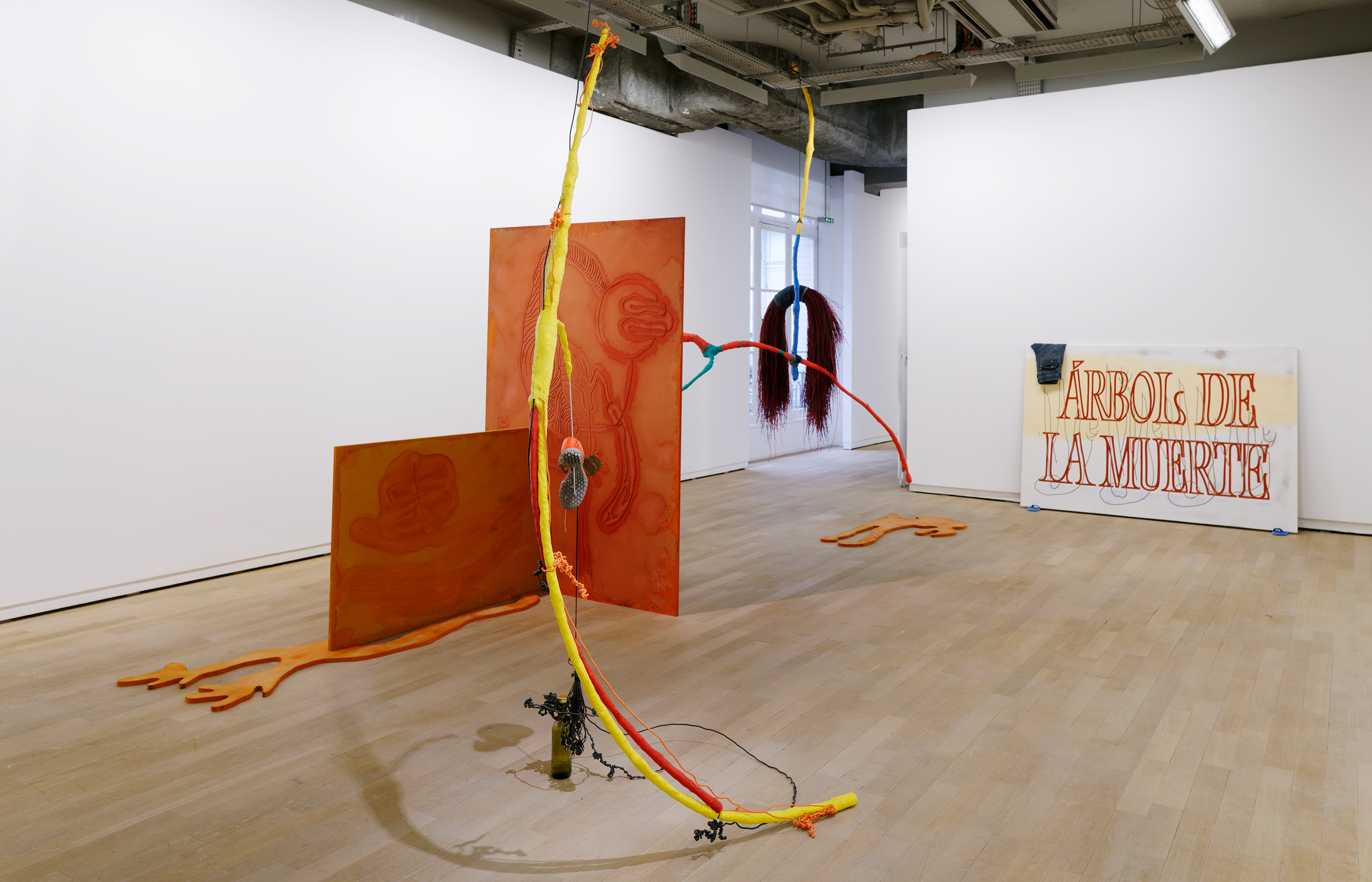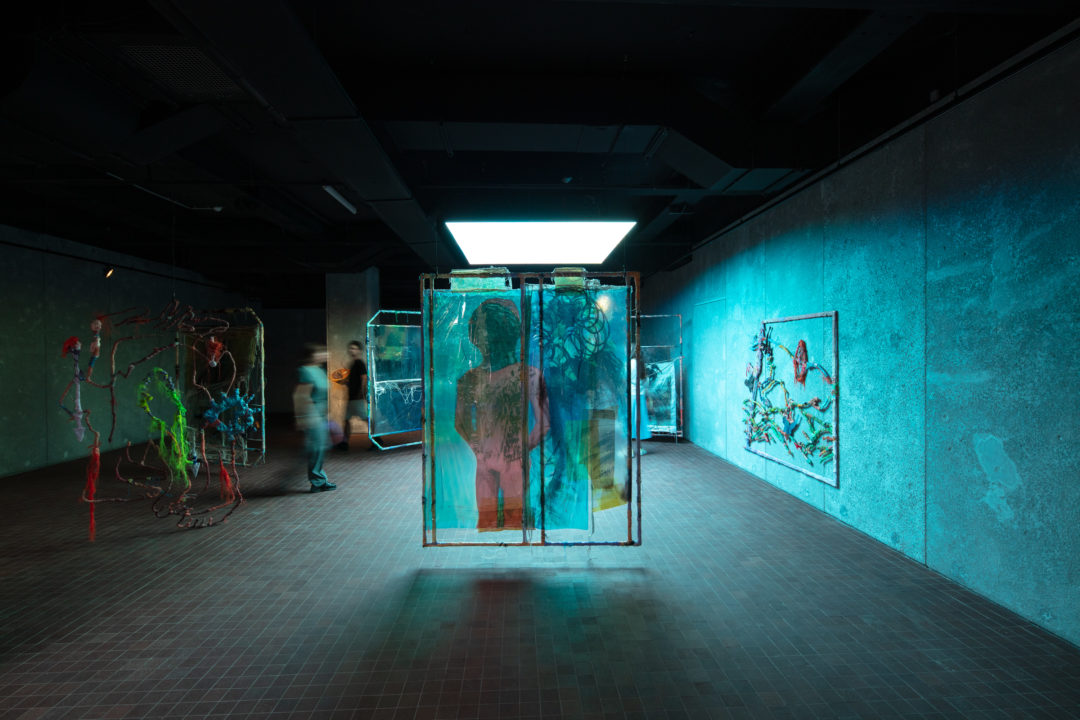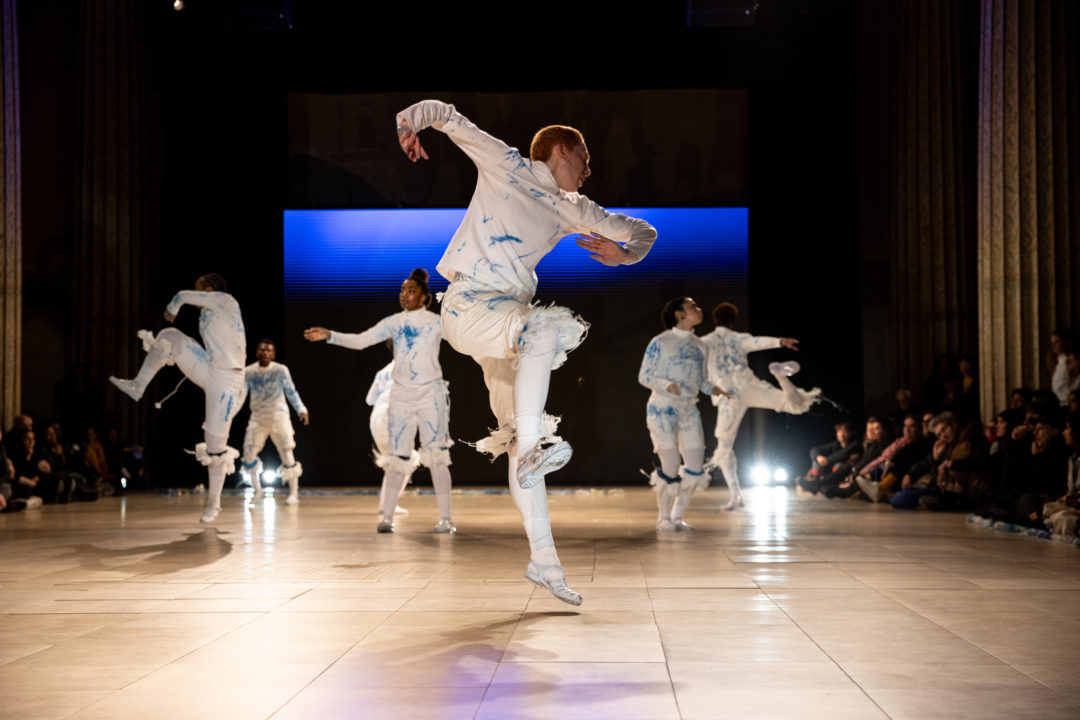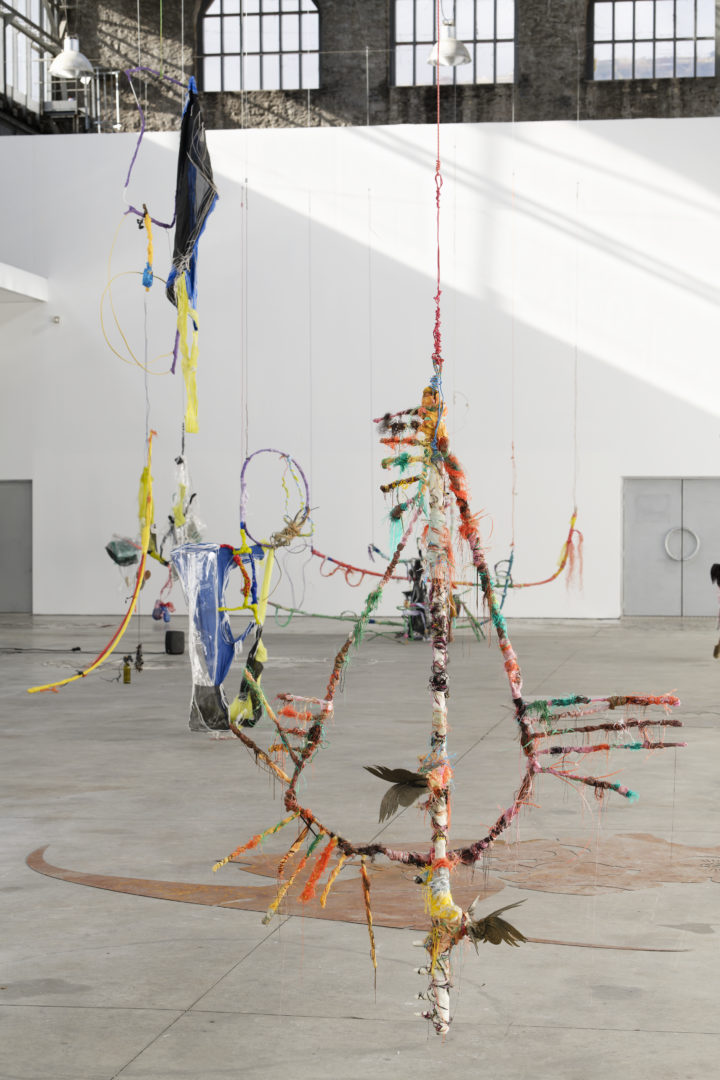Julien Creuzet

What is the standard height of a chair? What is the depth of a closet? In 2008, in the early stages of his career, Julien Creuzet began focusing his minute attentions on the events of his daily life, painstakingly revealing the weight of the past and the ever-political aspects of each element as they come into play in the infra-ordinary. The artist’s perspective of the world is informed by his personal life and the events which occur within; the works are immersed in this vision, although they never give themselves away completely. Like a magician, the artist entrances us with his tricks, never disclosing his secrets. Through the sharing of personal experience, the artist nonetheless manages to address universal and contemporary issues. In the context of the financial crisis of 2008, for instance, where does the individual stand if the very notion of State sovereignty has been called into question by credit scoring agencies like Standard & Poor’s? If we consider the polysemic nature of the word standard, we find ourselves tossed from one dominant construct to another: from contemporary finance with its abstract criteria of stability, to slave ships with their standardised and optimised spaces; both trade in bodies and lives as if they were mere numbers or merchandise.
In contrast with American canonical notions of contemporary art, Creuzet employs fragile forms, adding organic elements to found objects with unstable contours: sugar, sea-shells, straps, clothing, hair…These plastic rudiments embrace a continually expanding aesthetic vocabulary. The artist also establishes the tangible footholds of a systematic denunciation of toxicity and colonial poisoning through seemingly mundane details: from the packaged sugar cubes of Standard & Poor’s, Cuore (2012) to the roucou of Opéra-archipel, j’ai vu le ciel en feu […], (Opera-Archipelago, I Saw the Sky Burning (…) (2015) which stretches across the ceiling of the Frac Basse-Normandie—an important reference to the importation of the Caribbean spices which give Mimolette cheese its orange hue—sometimes reaching a scandalous level: that of the chlordecone which turns bananas and bodies to rot in the video Mon corps carcasse […] (2019) (…) (My Body Cadaver). Subtle and explicit by turns, such as in the 2018 exhibition at the Fondation Ricard, “Toute la distance de la mer […]” (“The Entire Distance of the Sea”) the toxic sludge of slavery is at long last revealed to any and all.

Not satisfied with the shifting of formal paradigms alone, Julien Creuzet also defies normativity along with everything it imposes on artistic creative processes. Notions of beauty are defined by academia; they are the expressions of dominant culture and a form of intellectual policing, or rational primacy. When understanding trumps the senses, we bypass the artwork and head directly for the wall text. In the early 2010s, Julien Creuzet incorporated a poetic strand into his work and never turned back. He began to make space for speech in his first videos; for words in his titles which provide physical points of entry to his works. Rather than trying to understand them at all costs, the works guide us toward a lived experience through sensations, through straightforward spatial environments which are carefully orchestrated, or through a fortuitous air current which causes a sculpture to move as we pass. This deconstruction of scientific knowledge is achieved through the use of conceptual and artistic sources from the margins of dominant thought. One of these minority voices— that of Aimé Césaire with his play, La tragedie du roi Christophe (The Tragedy of King Christophe)—which narrates the Haitian revolution, is seen through the lens of a Voodoo temple in the video Les Possédés de Pigalle (…) (The Possessed of Pigalle) (2023). There are also David Hammons and Wifredo Lam, to whom Julien Creuzet pays homage in the video Dans les profondeurs de Lam (…) (2014) (In The Depths of Lam).
Nicki Minaj is also here, in the form of a poster which springs from a wicker basket, as is the musical group X-Mayela, whose poster appeared in the 2015 exhibition “Scroll Infini” (Infinite Scroll) at Noisy-le-Sec Gallery. In Oswald de Andrade […] (2021), Creuzet appears as his ectoplasmic alter ego who lists off a bibliography made in collaboration with poet and writer Estelle Coppolani. The list is presented in no particular hierarchical order, but more as an effort to create an intersectional corpus with theoretical references which also imbue the works with a pop culture charm; all with an eye toward the theories of Édouard Glissant. 2015 coincides with the first Opéra-archipel (Opera-Archipelago) and an effort by the artist to manifest his position within the author’s archipelago-oriented vision, transposing the concept to the visual arts. Each of these elements thus becomes an island emerging from within a wider ensemble, a “chaos-world” rendering that which is submerged invisible yet nonetheless still there through the breaths, the in-between spaces, the emptiness. The group, dispersed as it may be, still forms an ensemble and manages to come together without acquiring a culminating centre.
In addition, Opéra-archipel (Opera-archipelago)elicits the opportunity to dissect two narrative and cultural archetypes which have continued to uphold racist French-colonial ideologies of exoticization: Jean-Philippe Rameau’s1753 opera by Les Indes galantes (The Amorous Indies), and the 1930s-era magazine, Toutes nos colonies (All Our Colonies). Through these two problematic references, Julien Creuzet presents exoticism as a manifestation of identity-relationships, which are always defined through one’s position with regard to others and through the process of passage. The artist traces the experiences and emotions produced by this exoticism from France to Martinique, all the way to Brazil, and everywhere the African diaspora has managed to appear; Paul Gilroy refers to this phenomenon as The Black Atlantic, “a space for cultural transnational construction.” In the 2023 video produced for the 35th São Paulo Biennale Zumbi Zumbi Eterno, and which was shown at Grenoble’s Magasin-CNAC, we are taken to the far reaches of the Atlantic, to follow the trail of anticolonialist icon Zumbi dos Palmares. We see his transparent body, transpierced with historic and religious elements: machetes, fufu fish, datura flowers, all important symbols of the emancipation of enslaved peoples. The sound of water, percussions and sung poetry all call for the transmission of this memorial through a silent and meditative resistance. From the depths of the ocean seem to rise the murmur of bodies which have succumbed to being thrown overboard in transit during the slave trade. These forgotten souls cause an uptick in the population of those who have been erased, marginalized and broken by history—they are at the heart of the artist’s personal pantheon, gathered together side-by-side with divinities they acquire mystical powers.
The search for ancestorship imbues Creuzet’s practice, drawing inspiration from African religious rites and beliefs: the money cowrie divination ritual in particular, which allows practitioners to communicate with the spirit world—in this case, Mathilda Beauvoir, or “Manbo”, grand priestess of a Voodoo temple. African statuary becomes the artist’s personal cosmogeny, in a fabric-shrouded version in Standard & Poor’s, afro-américain (Standard & Poor’s, African-American)(2013), now sewn with golden thread in Nos mouchoirs agités […] (Our Handkerchiefs Waving) (2015), suspended by a laundry drying rack in Vital mouvement […] (2016), animated and dancing in Sonjé yo (2022).
The attempt to make contact with the supernatural world and mythological communion are brought together in a jarring encounter with digital tools, computers, telephones… Internet being for the artist, a territory to be occupied and subverted. In the video Oh Téléphone, oracle noir […] (Oh Telephone, Black Oracle) (2015), whose title was borrowed for the Magasin-CNAC exhibition (a preamble to the Venice Biennale’s 60th International Art Exhibition, during which Creuzet will represent France), the telephone becomes an obsidian stone; a talisman onto which the artist confers the protection of his œuvre. The works feature a filigree of digital allusions, a type of ultra-contemporary obsession—In Je me martèle la tête […] (I Bang My Head) (2014) there is Google Drive, the 2015 Noisy-le-Sec exhibition was titled “Scroll infini” (Infinite Scroll). The artist even appropriates the immediacy of the tool; a fact which has accompanied him throughout his career, beginning with his first lo-fi videos—such as in J’ai fait plusieurs fois le même rêve […] (I Had a Recurring Dream) (2014), where he holds up a celluloid image of a boat in front of the lens of his mobile phone—right up to his present-day installations, where the video screens take on the vertical rectangular format of a mobile screen.

Emojis are combined with the French, English and Creole languages, as well as with poetry—at times recited, other times sung or written—in an attempt at a kind of universal language, where dance, music and bodies create a language of their own in order to make up for the shortcomings of orality.
Beginning in 2015 with Opéra-archipel (Opera-Archipelago), dance took centre stage, becoming a major element in the artist’s work. A reading and performance, danses païennes et corps critiques (Pagan Dances and Critical Bodies) organised with the Afro-Caribbean Jo’School (Noisy-le-Sec dance association), Ana Pi (dancer and choreographer), Fannie Sosa (sociologist and performer) and Elsa Dorlin (philosopher) addressed issues of the eroticisation of Black bodies through a variety of iconic figures ranging from Josephine Baker to Rihanna, and incorporating performativity and resistance through dance. Bodily movements in dance contain a potential to transmit and conserve heritage. For example, in Crossroad (2022), the artist’s transparent alter ego learns the bèlè, a traditional dance with origins in enslaved populations; an emotional and bodily form of movement and a decisive way to “change oneself by exchanging oneself,” as Edouard Glissant has suggested.
Julien Creuzet’s devotion to making languages coexist can also be located in the types of materials he chooses for his sculptures. In 2017, he began to integrate wires and cables into his sculptures, which he also began suspending, making them into objects which were potentially “placeless and without a past,” a precariousness which could condemn them to disappearance like the “disseminated elements” of Édouard Glissant. The sculptures become aerial, swaying sometimes like reeds under the weight of the colonial reminiscences they have steeped in. They hang together in equilibrium, serving as a counterweight for the other components. The artist’s approach involves association and collage; to compose an exhaustive list of all of the elements which make an appearance in the sculptures would be quite the feat. Among them are: feathers, rice, plastic wrappers, forks, goat skin, shoe fragments, lemon…
These appearances are either singular or recurrent such as with the bottles—in the photograph and installation J’ai marché, pour photographier, mes formes-mondes, (I Walked, So As to Photograph, My Form-Worlds) (2014) they are made of plastic, in Opéra-archipel, sépulture, les toucans, les perroquets sont les oiseaux les plus coloriés […] (Opera-Archipelago, Sepulture, Toucans, Parrots Are the Most Colourful Birds) (2015) they are glass, and in Opéra-archipel, la goutte d’or […] (Opera-Archipelago, The Drop of Gold) (2015) they are sheathed with a gold lamé hairnet. From boats to bottles, the imagination oscillates from one symbol to the other; one a remnant from the past and the epoch of the triangular trade system, the other referencing bottles of rum, the symbol of sugar plantations and slavery.
The sculptures trace a horizon line across the space; they form a fractured geography which projects shadowy, almost cabalistic shapes onto the walls. This cartography, whether it be mental or spatial, hanging or laser-cut and placed onto the floor, allows us to access a certain insularity, of the resurgence of land in the middle of an expanse of water, and of wandering as the refusal of the imposition of a single, lone viewpoint.

Julien Creuzet uses this type of collage method in this videos, as well, by layering different categories of images and audio tracks on top of one another. His voice reciting a poem embraces the repetitive musical backing rhythms. An engaging afro-pop track seduces us with its dynamism, only to be confronted by representations which are eminently political and denunciatory. In Cloud Cloud Glory […] (2020), he uses either découpage or overlays to alter the illustrations from an anthropology book—plants, animals and human figures are all objects of curiosity to whom the artist restores their status of subject, cancelling their erasure and stigmatisation. In mon corps carcasse […] (My Body Cadaver) (2019), a poem, which has been set to music by Mo Laudi, becomes a ritornello which pulsates with contemporary and hypnotic patterns—forming the transition to a serious discussion on chlordecone—and is then wrenched between 3D montages featuring games and music videos which have been combined with a 1990s aesthetic. Drenched in blood-red, our retinas are flooded with images of the French flag, bananas, pills, pellets, coins; a shot of a visual and auditory concoction which stays with us long after ingestion.
I would be remiss if I were to neglect mentioning the humanity behind each artwork, a feeling of companionship which radiates throughout all of the exhibitions. Julien Creuzet creates a tightly-woven relational archipelago around himself, while avoiding become the nucleus. Over the years—beginning with the very first show at Dohyang Lee Gallery—the artist has cultivated a network of creative and intellectual affinities, leading to the formation of a family of selected co-workers made up of artists, thinkers, dancers, sometimes gardeners as at the Noisy-le-Sec Gallery. This neighbourhood corresponds to Édouard Glissant’s concept of identity-relationship and is made up of processes, compositions and recompositions, shot through with the forms and physical traces made up by the artworks.
1 Translator’s note : The title is a play on the French idiom, “Dans les profondeurs de l’âme,” or The depths of the soul.
2 Yan Ciret, Chroniques de la scène monde : essais et entretiens, La passe du vent, 2000
3Ibid.
4Ibid.
______________________________________________________________________________
Head image : Julien Creuzet, Fondation d’entreprise Ricard , 23.01 – 19.02.2018. Photo : Aurélien / Fondation d’entreprise Ricard.
- From the issue: 108
- Share: ,
- By the same author: Ndayé Kouagou, Chloé Delarue ,
Related articles
Iván Argote
by Patrice Joly
Laurent Proux
by Guillaume Lasserre
Diego Bianchi
by Vanessa Morisset

